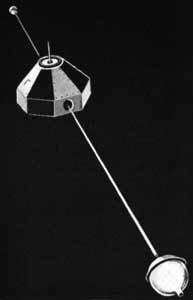Top Qs
Timeline
Chat
Perspective
Gravity Gradient Technology Satellite
U.S. Gravity Gradient Satellite From Wikipedia, the free encyclopedia
Remove ads
The Gravity Gradient Test Satellite was launched by the US Air Force from Cape Canaveral LC41 aboard a Titan IIIC rocket on June 16, 1966, at 14:00:01 UTC.[3] The satellite was launched along with seven IDCSP satellites, with which it shared a bus.[4] In contrast to the solar-powered IDCSP satellites, GGTS was battery powered.[4]
This article may contain excessive or inappropriate references to self-published sources. (August 2024) |
GGTS utilized the 26.4-pound (12.0 kg) Magnetically Anchored Gravity Systems (MACS), which consisted of two identical subsystem packages, each containing an extensible rod unit and a magnetically anchored spherical viscous damper.[5] The rod units had an extended length of 15.8 meters (52 ft),[5] and their 5-kilogram (11 lb) damper tip weights gave the satellite a symmetric dumbbell configuration.[5] The dampers were produced by General Electric and consisted of two concentric spheres separated by a viscous damping fluid.[5] The internal sphere contained a hollow cylindrical magnet which served to "anchor' the inner sphere to the Earth's magnetic field,[5] stabilizing the satellite over time.[4]
It had been hoped that within 60 days of launch, the satellite would reach a stabilization of ±8° on the x- and y-axis.[4] The results were compromised, as one of the dampers was magnetically contaminated.[4]
A follow-up GGTS mission was lost due to a launch vehicle failure on August 28, 1966.[4]
Remove ads
See also
References
Wikiwand - on
Seamless Wikipedia browsing. On steroids.
Remove ads

